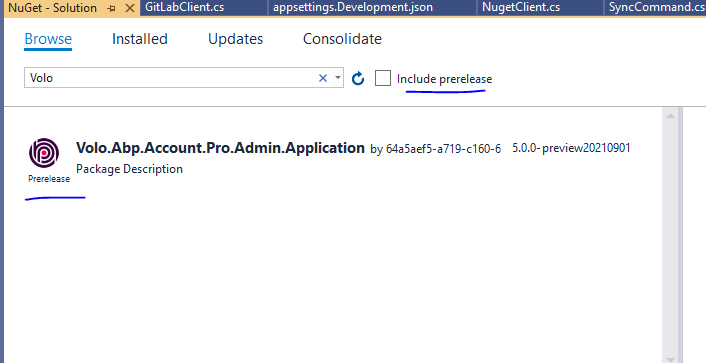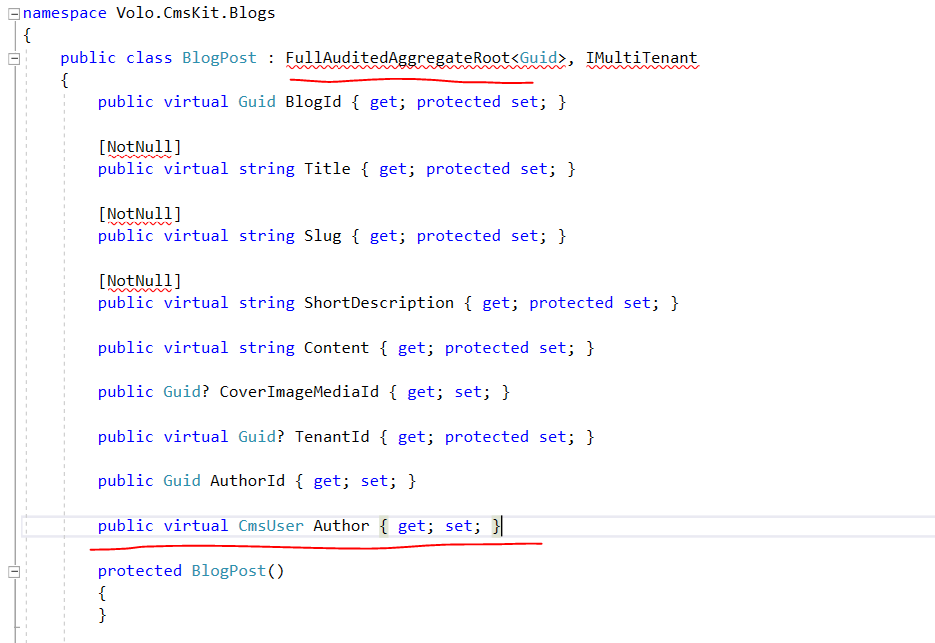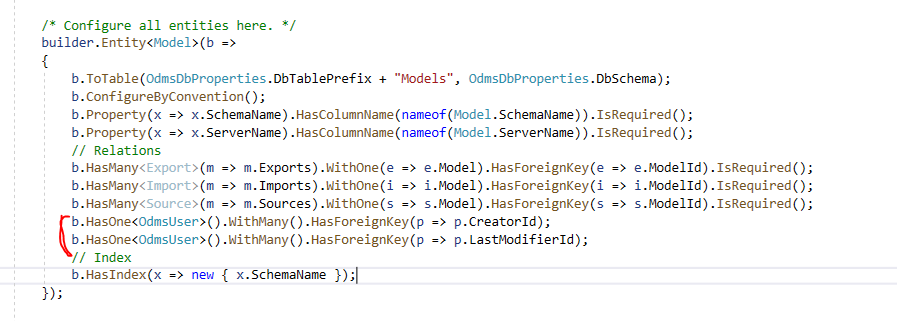Activities of "selinkoykiran"
Hello all,
Is it possible to override one of the AbpModule itself ? There are lots of way inside the below link: https://docs.abp.io/en/abp/latest/Dependency-Injection#DependencyInterfaces But none of them are mentioning about overriding or replacing a module itself. For example I want to change AbpBackgroundWorkersModule module's ConfigureServices method inside, how can I do that ? Thank you.
- ABP Framework version: v5.1.1
- UI type: MVC
- DB provider: EF Core
- **Tiered (MVC) : yes
- Exception message and stack trace:
- Steps to reproduce the issue:"
Hello all,
NOTE => First of all we've found this usage by searching from your code, could you please share a usage of DynamicOptions inside your docs , too ?
The usage sample like below :
We have an optionsManager
 Then an options class :
Then an options class :

And the configuration is like below :
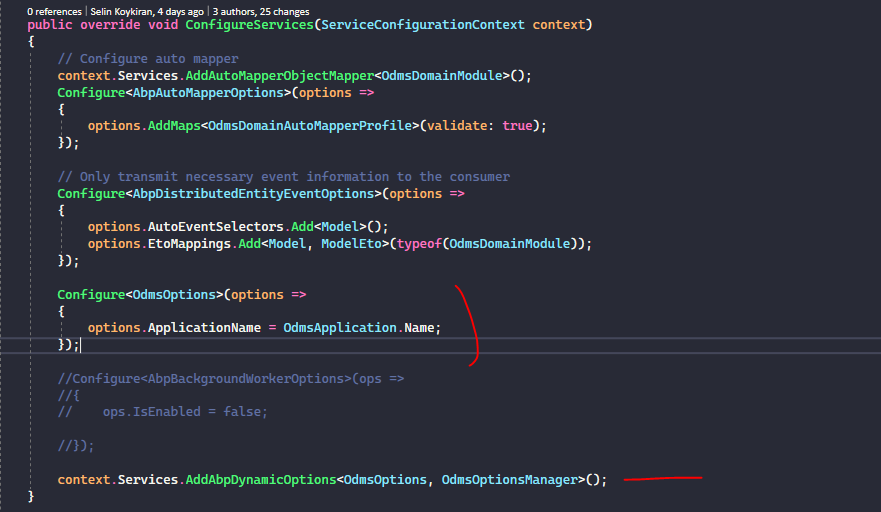
We are settings OdmsOptions inside SettingAppService like below :

When a person changes the options from setting page, we are just updating our options with Set() method call.
After that we want to get the latest options with injecting this Option class like below :
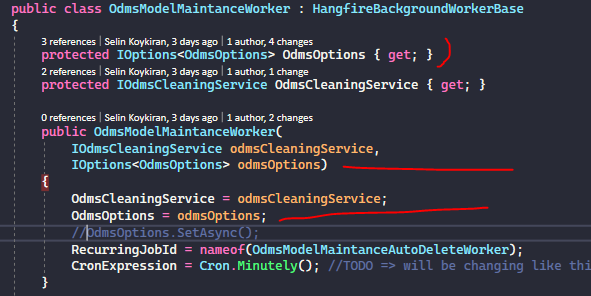
But after injecting this OdmsOptions class we are getting default options, not setted options. Why the behaviour is like that. We needed to call OdmsOptions.SetAsync(); method again to get latest settings, Why do we need another Set method call , we've already done this setting in another place. When we are injecting the Odmsoptions , should we get the latest changes without calling another set method ?
Could you check and help please? Thank you.
- ABP Framework version: v5.1.1.
- UI type: MVC
- DB provider: EF Core
- **Tiered (MVC) : yes
- Exception message and stack trace:
- Steps to reproduce the issue:"
Hello all,
We're using hangfire background worker in our project we we're referenced this library in our dependent modules like below :
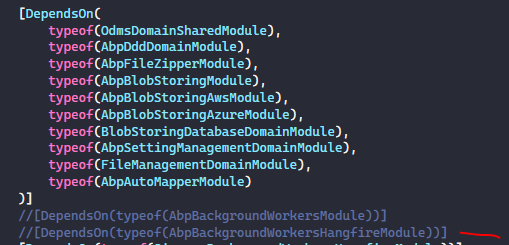
But this module has an issue , after that module is injected in our domain module , we are getting errors like below at irrelevant places like identity Server .
We've disabled the usage of backgroundworker and job inside of Identity Server Module :

But exception is still occurring. We've trace your code and we are thinking the base problem is in AbpHangfireModule
We're thinking this issue is occurring because of wrong ordered configuration .
You can see below your AbpBackgroundWorkersHangfireModule using AbpBackgroundWorkerOptions .

when we disable the AbpBackgroundWorkerOptions , it'll pass the exception but it'll continue with below module which is AbpHangfireModule.
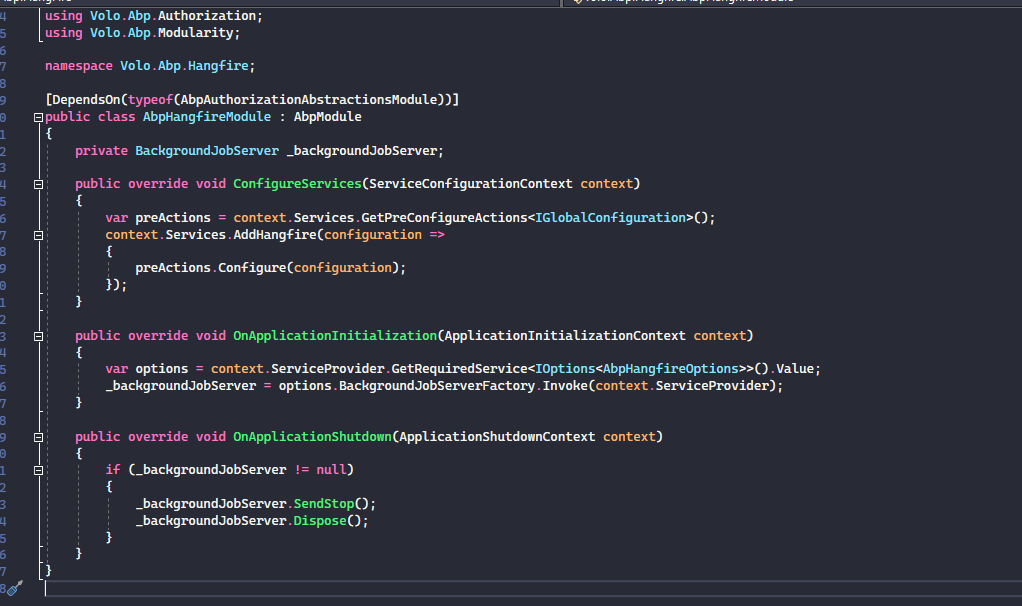 So because of the OnApplicationInitialization method , even we don't have any job storage for example inside Identity Server module, we're getting below irrelevant exception.
So because of the OnApplicationInitialization method , even we don't have any job storage for example inside Identity Server module, we're getting below irrelevant exception.
Could you check the usage of this module. We are bypassing the problem like below in our project , we just wrapped exception with try catch and we don't do anything (override the AbpHangfireModule like below ):
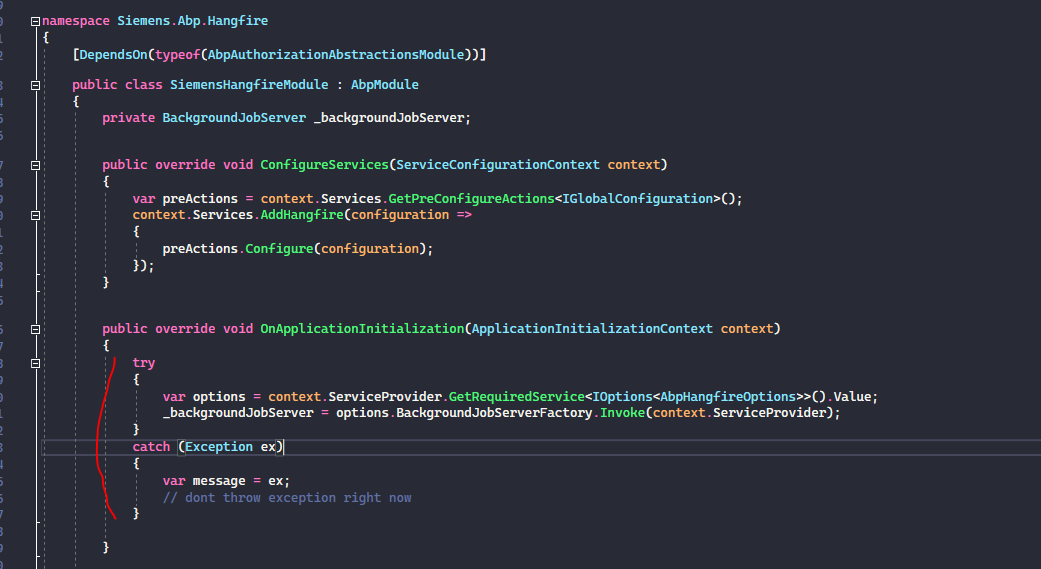
So with this bypassing we can use IdentityServer and other related modules with hangfire module without exception.
But we're thinking you should check this one.
Thank you.
- ABP Framework version: v5.1.1
- UI type: MVC
- DB provider: EF Core
- **Tiered (MVC) : yes
- Exception message and stack trace:
- Steps to reproduce the issue:"
Hello all,
We came up to an issue with abpContext and ef core.
We have an entity which is using ISoftDelete interface like below (and default behaviour is cascade delete with parent ).

And this entity is the child of parent Model aggregate root. We have a case like => we want to mark as deleted this entity and after we want to hard delete this entity from database without deleting parent Model entity. We are getting these children from db like below :
after that point we are operating deletion inside rich domain model like below (with removeall or clear it doesn't metter, it's not working):
So this operation should mark exports as deleted(in ef core state) and after saveChanges operation it should be deleting all exports from db. But nothing happened. (we also check with sql profiler , there wasn't any deletion operation which should be seen ). And as ef core state we also can't see the state change , children entity stayed as unchanged .
We've also checked this issue without abp library with just using ef core library. And with default ef core lib , we can get included children with parent, after that we marked these children with removeAll or clear methods and it worked as expected and this operation deleted all the children of the parent object without deleting parent. So we're thinking that this issue is related with abp framework library . Could you help with that issue , please ? It's really important for us.
Thank you.
- ABP Framework version: v5.1.1
- UI type: MVC
- DB provider: EF Core
- **Tiered (MVC) : yes
- Exception message and stack trace:
- Steps to reproduce the issue:"
Hello , We have an aggregate root with child entites. Aggregate root is related with entites with foreign key . We want to listen deletion event of these child entities. They are deleting with cascade mode, so when aggregate root is deleted their child entities also will be deleting. But with below implementation child entity deletion handler never triggering ? Note => By the way aggregate root event triggering is working fine. This situation is for cascadely deleted entities.
Thank you.
Check the docs before asking a question: https://docs.abp.io/en/commercial/latest/ Check the samples, to see the basic tasks: https://docs.abp.io/en/commercial/latest/samples/index The exact solution to your question may have been answered before, please use the search on the homepage.
If you're creating a bug/problem report, please include followings:
- ABP Framework version: v4.4.4
- UI type: MVC
- DB provider: EF Core
- Tiered (MVC) or Identity Server Separated (Angular): yes / no
- Exception message and stack trace:
- Steps to reproduce the issue:"
Hello ,
We are using abp Check class for null or whitespace conditions in all layers and we saw that when a validation error happens in the domain side while checking, user will see the below exception :
We are using this check class in every layers of our application like in domain , application, web. By the way If we use validators on web, application layer , we can see more reasonable messages (because when using validators, abp wraps this kind of check exceptions inside AbpValidationException, so we could see validation exception messages on swagger for example. ) But for example we are using Check class in our domain layer and we can't or don't use any validator , in that case how can we customize this exception message ? Do we need to wrap, all Check class used code lines with try catch blocks at everywhere ? Is there any option for this or do we need to write custom exception handling middleware for that ?
Note = By the way we've tried to use string message option of Check.NotNull() method. But it just wrote this custom message into the log file, An internal error occurred during your request message did not change.
Thank you.
Check the docs before asking a question: https://docs.abp.io/en/commercial/latest/ Check the samples, to see the basic tasks: https://docs.abp.io/en/commercial/latest/samples/index The exact solution to your question may have been answered before, please use the search on the homepage.
If you're creating a bug/problem report, please include followings:
- ABP Framework version: v4.4..0
- UI type: MVC
- DB provider: EF Core
- **Tiered (MVC) : yes
- Exception message and stack trace:
- Steps to reproduce the issue:"
Hello, We have still netstandard2.0 targeted framework projects in our team .In one of our project we want to use Volo.Abp.AspNetCore 4.3.3 package and we've realized the dependency like below :
so we couldn't use the package. That's not a problem actually , we need to change target framework to .net 5 .That's ok from our side. BUT for example Volo.Abp.AspNetCore.Mvc.Contracts package still can work with .net standard like below :
So do you think is there any incosistency between these volo packages ? Why some of them support .net 5 and above and some of them still in .net standard ?
Thank you.
- ABP Framework version: v4.3.3
- UI type: MVC
- DB provider: EF Core
- Tiered (MVC) or Identity Server Separated (Angular): yes / no
- Exception message and stack trace:
- Steps to reproduce the issue:"
Hello ,
We want to use ef core IModelCacheKeyFactory feature to able to create differently named tables with same entity. I'm sharing the link below which is similar with our case : https://yanxiaodi.medium.com/mapping-the-model-to-multiple-tables-with-entityframework-core-b46bdeed8661
So, I've searched and taken a look to this page https://docs.abp.io/en/abp/latest/Entity-Framework-Core . I just couldn't figure out how can we implement this scenario. I've checked MapEfCoreDbContext and EfCoreEntityExtensionMappings concepts. I need to make that implementation before dbcontext creation , so could you help us about that issue?
Thank you.
Check the docs before asking a question: https://docs.abp.io/en/commercial/latest/ Check the samples, to see the basic tasks: https://docs.abp.io/en/commercial/latest/samples/index The exact solution to your question may have been answered before, please use the search on the homepage.
If you're creating a bug/problem report, please include followings:
- ABP Framework version: v4.4.0
- UI type: MVC
- DB provider: EF Core
- Tiered (MVC) or Identity Server Separated (Angular): yes / no
- Exception message and stack trace:
- Steps to reproduce the issue:"
Hello, We are developing a CI/CD pipeline project and downloading nuget commercial abp packages with code , we call rest api.
But even we don't check for "include prerelease" option , we are still getting prerelease versions from nuget like these packages are the lastest stable ones (ilke below), we should be seeing latest stable version like 4.4.0 or something.
So could you please give information about this situation ? Could anything be wrong about your nuget packaging options ?
Thank you.
Check the docs before asking a question: https://docs.abp.io/en/commercial/latest/ Check the samples, to see the basic tasks: https://docs.abp.io/en/commercial/latest/samples/index The exact solution to your question may have been answered before, please use the search on the homepage.
If you're creating a bug/problem report, please include followings:
- ABP Framework version: v4.4.0
- UI type:MVC
- DB provider: EF Core
- Tiered (MVC) or Identity Server Separated (Angular): yes / no
- Exception message and stack trace:
- Steps to reproduce the issue:"
Hello, We want to use your UserSynchronizer solution to synchronize user data between microservices and we saw the example inside CmsKit module. But here we have a question. We want to make a relation between our CreatorId which comes from Audit entity and our custom User table inside microservice. Below code, you uses CmsUser entity inside BlogPost entity directly.
But we want to make an implementation like below :
So we are wondering if is there any spesific reason for not using audited entity property ? Why did you put CmsUser as Author and add AuthorId instead of using CreatorId property from FullAuditedAggregateRoot ? Is our implementation also okay ?
Thank you.
Check the docs before asking a question: https://docs.abp.io/en/commercial/latest/ Check the samples, to see the basic tasks: https://docs.abp.io/en/commercial/latest/samples/index The exact solution to your question may have been answered before, please use the search on the homepage.
If you're creating a bug/problem report, please include followings:
- ABP Framework version: v4.3.0
- UI type: MVC
- DB provider: EF Core
- **Tiered (MVC) :yes -






